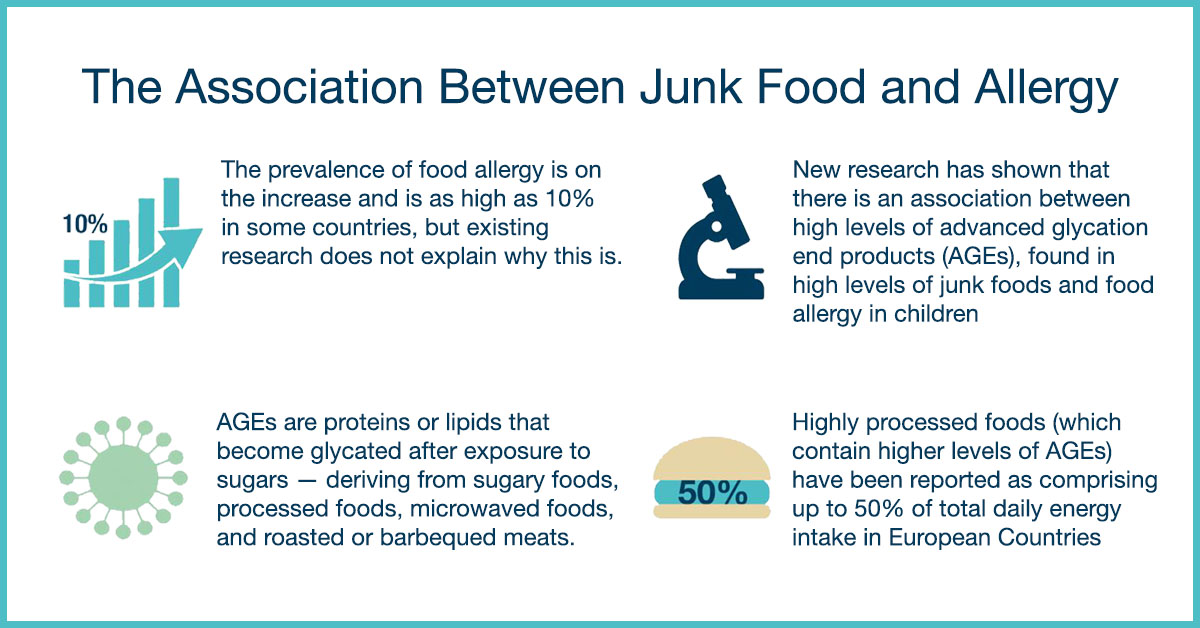SPINK HEALTH
(Glasgow, 8 June, 2019) Experts at the 52nd Annual Meeting of the European Society for Paediatric Gastroenterology, Hepatology and Nutrition are today presenting the results of a study that show higher levels of advanced glycation end products (AGEs), found in abundance in junk food, are associated with food allergy in children [1].
Researchers from the University of Naples ‘Federico II’ observed three groups of children aged between 6-12 years old (61 children in total): those with food allergies, those with respiratory allergies, and healthy controls. The study revealed a significant correlation between subcutaneous levels of advanced glycation end products (AGEs) and junk food consumption, and further, that children with food allergies presented with higher levels of subcutaneous levels of AGEs than those children with respiratory allergies or no allergies at all. In addition, the research team found compelling evidence relating to the mechanism of action elicited by AGEs in determining food allergy.
AGEs are proteins or lipids that become glycated after exposure to sugars [2] and are present at high levels in junk foods – deriving from sugars, processed foods, microwaved foods and roasted or barbequed meats. AGEs are already known to play a role in the development and progression of different oxidative-based diseases including diabetes, atherosclerosis (where plaque builds up inside the arteries), and neurological disorders [3] but this is the first time an association has been found between AGEs and food allergy.
While firm statistics on global food allergy prevalence are lacking, there is growing evidence that incidence is on the increase, especially amongst young children, and prevalence is reported to be as high as 10% in some countries [4,5,6]. Similarly, over recent decades there has been a dramatic increase in the consumption of highly-processed foods [7] (which are known to contain higher levels of AGEs), and highly-processed foods have been reported as comprising up to 50% of total daily energy intake in European countries [8].
Commenting on the research, principal investigator Roberto Berni Canani said:
“As of yet, existing hypotheses and models of food allergy do not adequately explain the dramatic increase observed in the last years – so dietary AGEs may be the missing link. Our study certainly supports this hypothesis, we now need further research to confirm it. If this link is confirmed, it will strengthen the case for national governments to enhance public health interventions to restrict junk food consumption in children.”
Isabel Proaño, Director of Policy and Communications at the European Federation of Allergy and Airways Diseases Patients’ Associations (EFA) added:
“These new findings show there are still many environmental and dietary issues affecting our health and wellbeing. Healthcare professionals and patients do not have all of the important information to face a disease that dramatically impacts their quality of life, and industrialised food processing and labelling gaps will not help them. We call on the public health authorities to enable better prevention and care of food allergy.”
###
Notes to Editors
For further information, to speak to Professor Roberto Berni Canani or an ESPGHAN expert, please contact James M. Butcher at james@spinkhealth.com or call +44 (0) 1444 811 099.
About the Expert
Professor Roberto Berni Canani is the Chief of the Allergy Program at the Department of Translational Medical Science and the Chief, ImmunoNutritionLab – CEINGE Advanced Biotechnologies Research Center at the University Federico II, Naples, Italy.
About ESPGHAN
The European Society for Paediatric Gastroenterology Hepatology and Nutrition (ESPGHAN) is a multi-professional organisation whose aim is to promote the health of children with special attention to the gastrointestinal tract, liver and nutritional status, through knowledge creation, the dissemination of science based information, the promotion of best practice in the delivery of care and the provision of high quality education for paediatric gastroenterology, hepatology and nutrition professionals in Europe and beyond. Find out more by visiting http://www.espghan.org
About the 52nd Annual Meeting of ESPGHAN
The 52nd Annual Meeting of ESPGHAN is taking place from 5-8 June 2019, at the SEC in Glasgow, United Kingdom.
Every year the ESPGHAN Annual Meeting attracts over 4,600 experts and key opinion leaders in the field of Paediatric Gastroenterology, Hepatology and Nutrition from 100 countries across Europe and all five continents, turning it into the largest conference of its kind worldwide.
The European Society for Paediatric Gastroenterology, Hepatology and Nutrition 52nd Annual Meeting in Glasgow is being supported by the VisitScotland National Conference Bid Fund and a grant from the Glasgow Convention Bureau. ESPGHAN would like to thank VisitScotland and the Glasgow Convention Bureau for their support.
For more information about the ESPGHAN Congress, including to view the programme, please visit: https://www.espghancongress.org/
References
1. Berni Canani, R, et al (2019). How junk food can contribute to the food allergy epidemic: the potential role of advanced glycation endproducts. Presented at the 52nd Annual Meeting of ESPGHAN.
2. Goldin, Alison, et al. “Advanced glycation end products: sparking the development of diabetic vascular injury.” Circulation 114.6 (2006): 597-605.
3. Vistoli, G., et al. “Advanced glycoxidation and lipoxidation end products (AGEs and ALEs): an overview of their mechanisms of formation.” Free radical research 47.sup1 (2013): 3-27.
4. Tang, Mimi LK, and Raymond J. Mullins. “Food allergy: is prevalence increasing?.” Internal medicine journal 47.3 (2017): 256-261.
5. Loh, Wenyin, and Mimi Tang. “The epidemiology of food allergy in the global context.” International journal of environmental research and public health 15.9 (2018): 2043.
6. Sicherer, Scott H., and Hugh A. Sampson. “Food allergy: a review and update on epidemiology, pathogenesis, diagnosis, prevention, and management.” Journal of Allergy and Clinical Immunology 141.1 (2018): 41-58.
7. Fiolet, Thibault, et al. “Consumption of ultra-processed foods and cancer risk: results from NutriNet-Santé prospective cohort.” bmj 360 (2018): k322.
8. Slimani, N., et al. “Contribution of highly industrially processed foods to the nutrient intakes and patterns of middle-aged populations in the European Prospective Investigation into Cancer and Nutrition study.” European journal of clinical nutrition 63.S4 (2009): S206.





